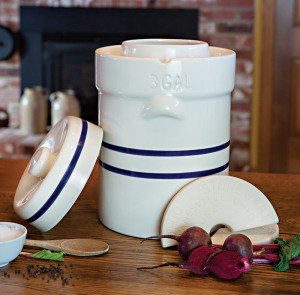Congratulations! You are about to discover one of the world’s oldest and healthiest methods of food preservation: lactic acid fermentation. This ancient method allows vegetables to retain more vitamins and minerals while improving their flavor and digestibility.
The ancient Romans, Chinese and Japanese all used lactic acid fermentation extensively. During the Middle Ages, it was well-known by seafarers that the high vitamin content in sauerkraut (pickled cabbage) protected one from getting scurvy and other illnesses. Because of its health benefits and ease of preparation, lactic acid fermentation (pickling) is experiencing a revival in Europe, North America and beyond.
Lactic Acid Fermentation: How It Works
Lactic acid-forming bacteria are naturally present in almost all vegetables and fruits. When allowed to take their natural course, these bacteria cause catabolic changes in certain sugars, resulting in two new products: lactic acid and carbon dioxide. The lactic acid breaks down foods, making them easily digestible. The carbon dioxide bubbles off through this crocks unique and sanitary water seal. Homemade sauerkraut, like natural yogurt, contains healthy live microbes. It also has very high levels of Vitamins B and C.
Because Lacto-Fermentation is a natural process, flavor varies depending on many factors. The same recipe made the same way and fermented in Minnesota will taste different than when it is fermented in Texas. Temperature and the amount of salt also affects flavor.
The salt prevents unhealthy spoilage and encourages healthy fermentation. Do not use iodized table salt, which may stop fermentation completely. Keep in mind that higher temperatures and less salt means faster fermentation. Cooler temperatures and more salt means slower fermentation. Most people prefer the taste of vegetables that are fermented (or pickled) slowly.
Home pickling is an adventure! We encourage you to experiment with different vegetables, salt levels and temperature to find the recipes that work best for you!
Health Benefits
Pickling is the most natural method of preserving all types of vegetables. While valuable vitamins and other nutritive substances can be lost by preserving, pickling actually enhances the health benefits of the vegetables with lactic acid, while allowing them to retain their vitamins and minerals. Pickled/fermented vegetables are:
• Stimulating to digestion and metabolism – often used in weight loss programs
• Low in calories (ex: 100g of sauerkraut has just 15 calories)
• Easily digested
• Loaded in vitamins (especially B and C)
• Easy to make at home!
Innovative Design
Our crock is designed to be much easier to use than traditional, open top stoneware pots, which must be tended often and very carefully. When kept in a cool, dark place (such as a basement), your crock can be left alone for weeks, even months, while the vegetables inside ferment safely. You will only occasionally need to top off the water in the gutter that makes a seal from the outside air.
Vegetables Recommended for Fermentation
• Beans
• Beets
• Cabbage
• Cauliflower
• Celery
• Cucumbers
• Onions
• Peppers
• Tomatoes
• Turnips
Using Your Crock Preparation: Cleanliness is very important, not only to prepare good quality vegetables, but also to maintain the crock and especially the lid. To clean, simply wipe, brush off or spray the inside and outside of the crock and lid, and the stone weights, and let them dry completely. Unlike other crocks, this one cannot absorb water, which can affect taste and preservation and cause mildew growth. The glaze prevents flavors being absorbed into the crock and transferring to or contaminating other vegetables.
Juice or brine should cover the vegetables about 4-6 cm (approx. 1 1/2″-2 1/2″). A brine of saltwater in a predetermined concentration (see
recipes) may be prepared by boiling and cooling the vegetable juice if there is not enough to sufficiently cover the vegetables. Linen cloths (traditionally used to cover the vegetables) are not needed as long as the crock and lid are kept clean. Lining the crock with large cabbage, grape or horseradish leaves is adequate.
Filling the crock: Vegetables should be clean and of high quality. Cut away all the damaged, bruised, brown or black parts. Remove stems, leaving only the best parts of the vegetable. Wash thoroughly. For sauerkraut, you can make clean and uniform slices (which are important) using a Cabbage Cutter.
After preparing the vegetables, fill the crock about 3⁄4 full. After the weight stones are placed on top of the vegetables, there should still be about 1” of space. The mixture of juice from the cut vegetables and brine (see recipes for details) should cover the weight stones by at least an inch. (This is to allow space for the carbonic acid which will accumulate later.)
Fill the gutter with water and place the lid on. Let stand at room temperature (64-68F) for 8-10 days to begin the fermentation process. Adding some whey, buttermilk or wine will encourage and speed up the process (see recipes).
You will hear an occasional “gurgle.” This is normal, and is caused by carbon dioxide leaving during the fermentation process. After 8-10 days, move the crock to a cook, dark place (such as a basement or root cellar) at approx. 40-47F.
Observation and Maintenance: Constantly observe the water level in the gutter, adding more as needed. Don’t worry if all the water seems to suddenly disappear from the gutter. Move the lid slightly (don’t lift it!) and you will see that the water is still there; the vacuum has just drawn it up inside the lid. Keep the lid on at all times to keep out dust, insects, etc.
After 4-8 weeks, depending on the type of vegetable, the finished vegetables may be removed. When removing vegetables, be careful not to keep the crock open any longer than necessary. Vegetables that are too sour can be tempered by mixing in some fresh ones.
If mold has formed on the surface of your brine, you can skim it off and discard. Your pickled food will not be harmed, since harmful microorganisms cannot survive in the acidic brine.

